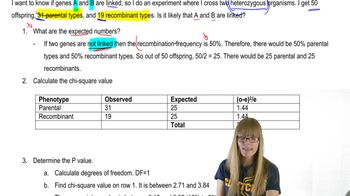4. Genetic Mapping and Linkage
Chi Square and Linkage
Practice this topic
- Multiple Choice
Black(B) rabbit coat colors are dominant to white(b) coat colors. Long hair (H) is dominant to short hair (h). A breeder crosses a rabbit homozygous for white, short hair with a homozygous black rabbit with long hair. The F1 is backcrossed to the rabbit with white, short hair and the following progeny are produced. Use the chi-square test to answer the following questions.
What are the expected offspring numbers if the two genes are not linked, and therefore assort independently?
538views3rank - Multiple Choice
Calculate the chi-square value for the above problem.
505views4rank - Multiple Choice
In this example, how many degrees of freedom should be used?
626views2rank - Multiple Choice
Using the appropriate chi-square value and degrees of freedom, do the coat color and hair length genes assort independently?
884views5rank - Textbook Question
Define linkage disequilibrium. What is the physical basis of linkage, and what causes linkage equilibrium? Explain how crossing over eliminates linkage disequilibrium.
763views - Textbook Question
Researchers cross a corn plant that is pure-breeding for the dominant traits colored aleurone (C1), full kernel (Sh), and waxy endosperm (Wx) to a pure-breeding plant with the recessive traits colorless aleurone (c1), shrunken kernel (sh), and starchy (wx). The resulting F₁ plants were crossed to pure-breeding colorless, shrunken, starchy plants. Counting the kernels from about 30 ears of corn yields the following data.
Why are these data consistent with genetic linkage among the three genes?
392views - Textbook Question
Three dominant traits of corn seedlings, tunicate seed (T-), glossy appearance (G-), and liguled stem (L-), are studied along with their recessive counterparts, nontunicate (tt), nonglossy (gg), and liguleless (ll). A trihybrid plant with the three dominant traits is crossed to a nontunicate, nonglossy, liguleless plant. Kernels on ears of progeny plants are scored for the traits, with the following results:
Could all three genes be carried on the same chromosome? Discuss why or why not.
822views - Textbook Question
Three dominant traits of corn seedlings, tunicate seed (T-), glossy appearance (G-), and liguled stem (L-), are studied along with their recessive counterparts, nontunicate (tt), nonglossy (gg), and liguleless (ll). A trihybrid plant with the three dominant traits is crossed to a nontunicate, nonglossy, liguleless plant. Kernels on ears of progeny plants are scored for the traits, with the following results:
If evidence of linkage is present, calculate the recombination frequency or frequencies from the data presented.
605views

